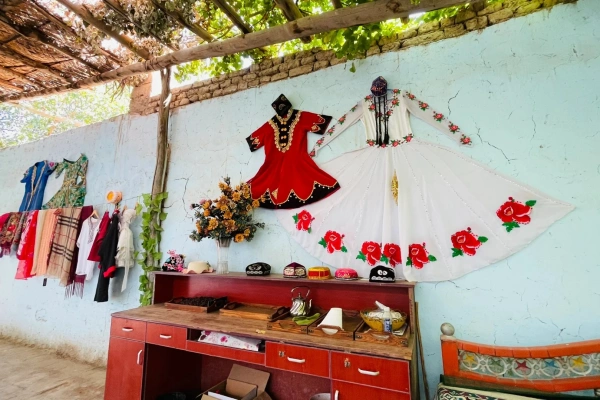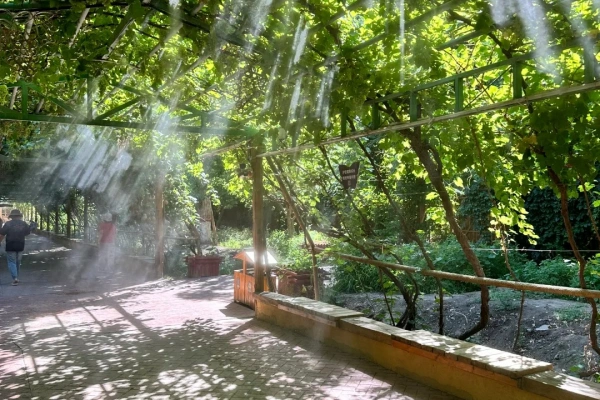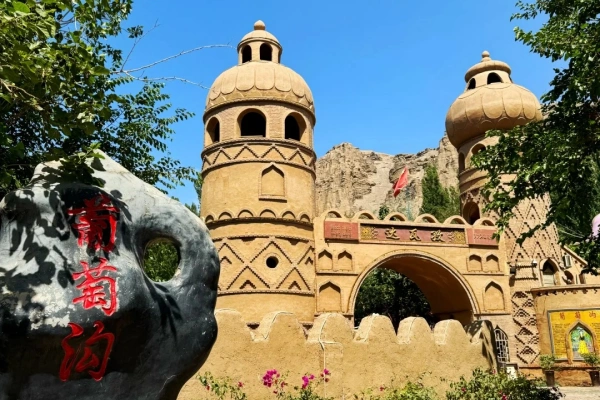Putao Gorge
Historical Background
Putao Gorge’s history as a grape-growing hub dates back over 2,000 years to the Silk Road era, when caravans paused here to trade fruits and spices. The Uyghur people, who settled in the region during the 9th century, perfected grape cultivation and winemaking, using ancient qanat irrigation systems to channel snowmelt from the Tianshan Mountains. By the Tang Dynasty ( 7th–10th centuries ), the gorge was famed for its "seedless white grapes," praised in poems by Li Bai and other poets. In the 20th century, modern agricultural techniques expanded production, while tourism emerged after the 1980s, blending farming with cultural preservation. Today, it stands as a symbol of Xinjiang’s multicultural heritage and agricultural ingenuity.
Geographical Features
Carved by the Goksu River through the Flaming Mountains’ red sandstone cliffs, Putao Gorge forms a narrow valley 5–10 kilometers wide, with elevations ranging from 500–800 meters above sea level. Its unique terrain creates a microclimate: cool breezes from the Tianshan Mountains meet the desert’s arid heat, resulting in mild summers ( 25–30°C ) and winters rarely dropping below -5°C. The gorge’s fertile alluvial soil, enriched by river silt, supports not only grapes but also apricots, melons, and walnuts. Key landmarks include the 20-meter-high "Grape Tunnel," a natural archway of intertwined vines, and the "Thousand Buddha Caves" ruins, which hint at ancient Buddhist settlements.

Major Attractions
Grape Valley: Wander through endless vineyards offering tastings of seedless white grapes, red grapes, and raisins. Visit traditional adobe houses with grape-drying lofts.
Uyghur Folk Village: Watch live performances of the Muqam ( Uyghur classical music ) and the energetic Dolun dance. Try handmade Uyghur bread ( nang ) and yogurt at family-run stalls.
Aydingkol Lake: Hike to this saltwater lake at the gorge’s edge, surrounded by moon-like landscapes and mineral springs.
Flaming Mountains Viewpoint: Capture panoramic views of the red cliffs that inspired the Journey to the West novel, with temperatures here soaring to 50°C in summer.
Ancient Qanat System: Explore the underground tunnels that have irrigated the gorge for millennia, a UNESCO-recognized engineering marvel.

Cultural Experiences
Putao Gorge is a living museum of Uyghur culture. Join a homestay to learn grape-picking and wine-making from local farmers, or try your hand at weaving colorful carpets using traditional looms. During the annual Grape Festival ( August–September ), the valley erupts with music, grape-stomping contests, and parades of donkey carts laden with fruit. Don’t miss the chance to savor polu ( spiced rice with carrots and mutton ), a Uyghur staple, or sip chay ( green tea ) in a shaded courtyard while listening to elders share folktales about the Silk Road’s legendary merchants.
Suggested Itineraries
Half-Day Tour ( 3–4 Hours )
Start at Grape Valley for a vineyard stroll and tasting → Visit the Uyghur Folk Village for a dance show → Hike to the Flaming Mountains Viewpoint → Shop for dried fruits and handicrafts at the exit market.
Full-Day Exploration ( 6–7 Hours )
Morning: Grape Valley → Ancient Qanat Tour → Lunch at a Uyghur homestay.
Afternoon: Aydingkol Lake hike → Muqam music performance → Sunset at the Flaming Mountains.
Evening: Dinner featuring polu and grilled lamb skewers → Stargazing in the desert-clear skies.
Practical Information
Ticket Purchase: Entry to Putao Gorge costs ¥60 ( adults ), ¥30 ( students ). Combination tickets ( including transport ) are available at the gate or via travel apps like Ctrip.
Opening Hours: 8:30 AM–7:00 PM ( April–October ); 9:00 AM–6:00 PM ( November–March ).
Guided Tours: English/Chinese tours ( ¥100–150 per person ) include stops at vineyards and cultural sites.
Accessibility: The valley is wheelchair-friendly, but some hiking trails are steep.

Transportation
By Train: Take the Lanzhou–Xinjiang High-Speed Rail to Turpan North Station ( 2.5 hours from Urumqi ), then a 40-minute taxi ride to the gorge.
By Bus: Daily buses depart from Turpan’s Jiaohe Bus Station ( ¥15, 1 hour ).
By Car: Rent a vehicle in Urumqi for a 3-hour scenic drive via the G30 Expressway.
Parking: Free lots at the entrance; shuttles run to key attractions ( ¥10 round-trip ).
Best Time To Visit & Tips
Peak Season: August–September ( Grape Festival, lush vineyards ).
Shoulder Seasons: May–June ( mild weather, fewer crowds ) or October ( autumn foliage ).
Avoid: July ( scorching heat ) and January–February ( cold, sparse vegetation ).
Tips:Wear a hat and sunscreen; shade is limited.
Bargain at markets for dried fruits and carpets.
Respect local customs: ask permission before photographing people.
Carry cash for small vendors; Wi-Fi is sporadic.

